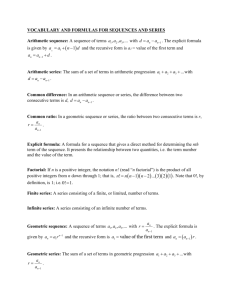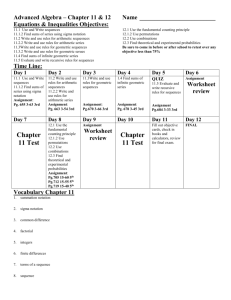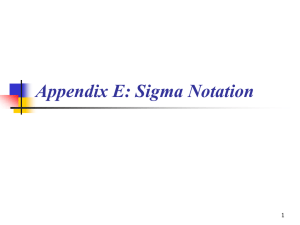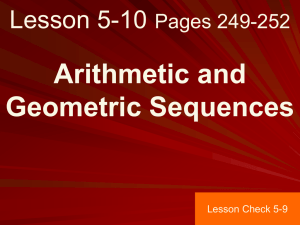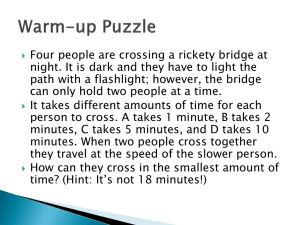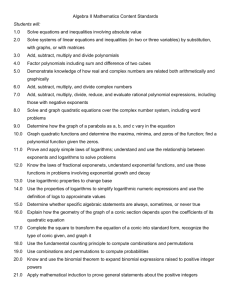Algebra 2, with Trig
advertisement
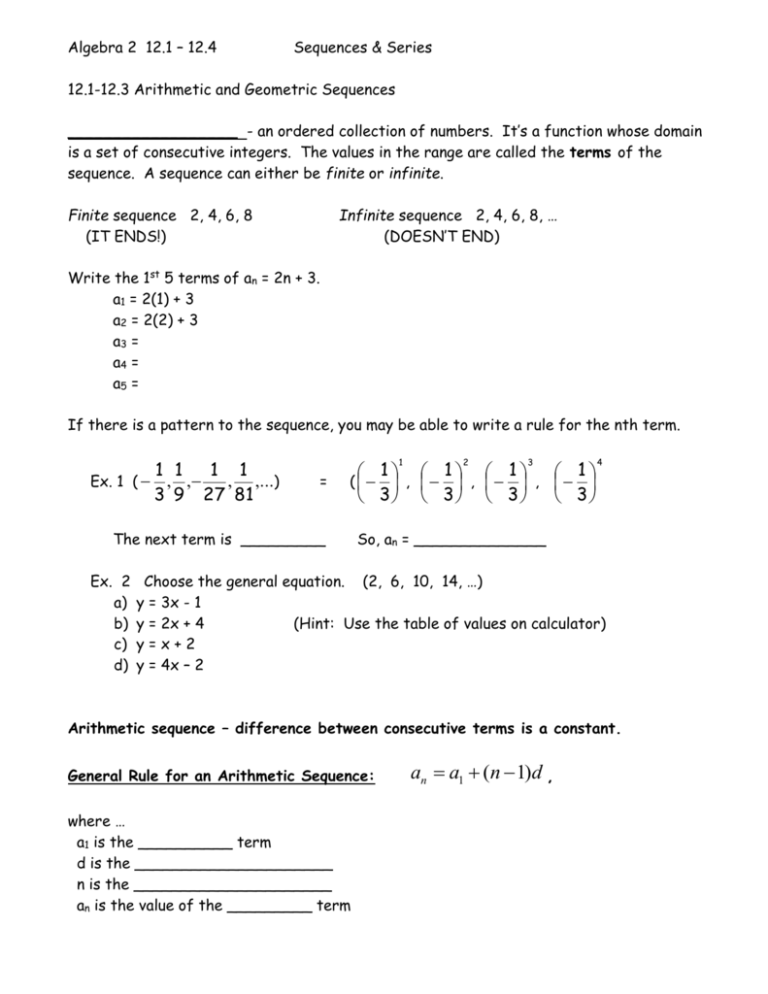
Algebra 2 12.1 – 12.4 Sequences & Series 12.1-12.3 Arithmetic and Geometric Sequences __________________ - an ordered collection of numbers. It’s a function whose domain is a set of consecutive integers. The values in the range are called the terms of the sequence. A sequence can either be finite or infinite. Finite sequence 2, 4, 6, 8 (IT ENDS!) Infinite sequence 2, 4, 6, 8, … (DOESN’T END) Write the 1st 5 terms of an = 2n + 3. a1 = 2(1) + 3 a2 = 2(2) + 3 a3 = a4 = a5 = If there is a pattern to the sequence, you may be able to write a rule for the nth term. 1 1 1 1 Ex. 1 ( , , , ,...) 3 9 27 81 1 = The next term is _________ Ex. 2 a) b) c) d) 2 3 1 1 1 1 ( , , , 3 3 3 3 4 So, an = ______________ Choose the general equation. (2, 6, 10, 14, …) y = 3x - 1 y = 2x + 4 (Hint: Use the table of values on calculator) y=x+2 y = 4x – 2 Arithmetic sequence – difference between consecutive terms is a constant. General Rule for an Arithmetic Sequence: where … a1 is the __________ term d is the _____________________ n is the _____________________ an is the value of the _________ term an a1 (n 1)d , Decide whether each sequence is Arithmetic, or neither. If it is Arithmetic, find using an a1 (n 1)d . 1. 1 1 1 1 , , , . . . A or 2 3 4 5 n 2. a10 −4, 4, 12, 20, 28 . . . A or n Geometric sequence – there’s a common ratio between terms. General Rule for a Geometric Sequence: an a1 (r ) n 1 where a1 is the _________ term of the sequence r is the ______________________ n is the ______________________ an is the _________ term of the sequence Ex. 1, 2, 4, 8, 16, 32, … Find a8 using an a1 (r ) n 1 . What is the ratio (r) ? _______ Decide whether each sequence is Arithmetic, Geometric, or neither. If it is Arithmetic or Geometric, find a7 by using either an a1 (n 1)d 3. 1, 2, 6, 24, 120, … A 5. 2, 5, 10, 17, 26, . . . A G G n n or an a1 (r ) n 1 . 4. 81, 27, 9, 3, 1, … A G n 6. 1, 3 5 , 2, , 3, . . . A 2 2 G n When the terms of a sequence are added, the result is a _________________. A series can either be finite or infinite. Finite series 2 + 4 + 6 + 8 Series – we can use Infinite series 2 + 4 + 6 + 8 + … which is called ________________ or ______________. 5 3i i1 Trick: y= (the expression) Go to the table. Grab the values between 1 and 5. Add them together. General Form for the Sum of the First n Terms in an Arithmetic Series: a an S n n 1 , 2 where… a1 is the ________ term an is the ________term n is the ___________ of terms 28 Ex. Find the sum of the arithmetic series (2 4i ) . i 1 A B C D 14 420 870 1568 General Form for the Sum of the First n Terms of a Geometric Series: 1 r n , r 1 S n a1 1 r where a1 is the _______ term r is the ______________ n is the __________ of terms Ex . Consider the following geometric series. Find the sum of the first ten terms. a) What is the sum of the first ten terms of 4 + 2 b) What is the value of the series below? k 1 6 + 1 + ½ + …? 3 4 k 1 2 A B C D 7. Find 15 (3 2i) . A or G ? i 1 16 8. Find 4(3)i 1 . i 1 A or G ? 275 8 729 16 665 8 2059 16 1 rn a1 an sn n or sn a1 2 1 r 1 rn a1 an sn n or sn a1 2 1 r Choose the best answer. 9. What is the third term of the sequence defined by an = 5n + 7? ________ 10. What is the next term in the sequence? 0, 2, 6, 12, 20 . . . ? ________ 11. Write out the series 3 (3i 4) ? i1 __________________________________ 12.4 Notes - Infinite Geometric Series Infinite Geometric Series: the sum of an infinite series that has a _________ An infinite geometric series may have a ___________, depending on the value of the common ratio. The Sum of an Infinite Geometric Series: S a1 , 1 r where a1 is the _________ term of the series r is the ____________________ and ____________ If |r| > 1, the series _______________________________ Ex 2 Does the infinite geometric series have a sum? 7 3 n 1 2 a) a1 ______ n 1 b) r _______ a)_________________ 1 4 6 n 1 a1 ______ n 1 c) 10(1) n 1 n 1 r _______ b)________________ Find the sum of the infinite geometric series if it has one. 4 4 b) 12 4 ... a) 2(0.1) i 1 3 9 i 1 a1 ______ r _______ c)_________________ Ex 3 a1 ______ r _______ a)_________________ a1 ______ r _______ b)________________ 3 9 27 c) 1 ... 2 4 8 a1 ______ A B C D r _______ -2 -½ 2 The series has no sum. 12.1-12.3 Sequences and Series Homework Day 1 4. 5. 6. 7. Is the sequence Arithmetic, Geometric or neither? If it is A or G then find 8. -2, 0, 2, 4, … 10. 40, 10, a7 by using either an a1 (n 1)d A 5 5 , ,… A 2 8 an a1 (r ) n 1 . n 9. 3, 6, 12, 24, … A G n G n 11. 4, 7, 12, 19, … A G n G a1 ____________ a1 ____________ a ____________ a an 1 S n n 1 an ____________ an ____________ 2 an ____________ 12) or 13) 14) 12.4 Sequences and Series HW Day 2 For #’s 1 – 3, find the sum of the infinite geometric series, if it exists. 1. 11 i 1 3 3 i 1 2. 3 i 1 i 1 3. 3. 4. Tell whether the sequence -7, -1, 5, 11, 17, 23, … is arithmetic. 7 5. Find the sum of the arithmetic series (4 i) . i 3 6. Tell whether the sequence 2 , 4, 24, 144, 864, … is geometric. 3 Algebra 2 Sequences & Series Review Ch 12.1-12.4 TAKE OUT ALL YOUR NOTES FROM CHAPTER 12 Write next the formula what it is used to find. a n a1 n 1d an a1 r a an S n n 1 2 1 r n S n a1 1 r n 1 S a1 1 r Ques. 1 – 2. Is each sequence arithmetic, geometric or neither? 1. 108, 54, 27, 13.5… 2. 19, 13, 7, 1, -5,… Ques. 3 – 4. Find the common difference or the common ratio. 3. -1, 4, -16, 64, … 4. 24, 29, 34, 39 … Question 5. Find a 20 . 5. 5, 13, 21, 29, … (Hint: Is it arithmetic or geometric?) Formula_________________ Question 6. Find a10 . 6. 3, 12, 48, 192, … (Hint: Is it arithmetic or geometric?) Formula_________________ Questions 7 – 8. Evaluate each sum. 25 7. 10 2i 1 8. i 1 32 i 1 i 1 Question 9. Find the sum of the first ten terms. 9. 11, 20, 29, … 10 (2 + 9i ) i1 a1 a10 Questions 10 – 11. Find each sum if it exists. Leave answers as reduced fractions. 10. 21.4 i 1 11. i 1 a1 2.4 i 1 i 1 r= _______ a1 r= _______

